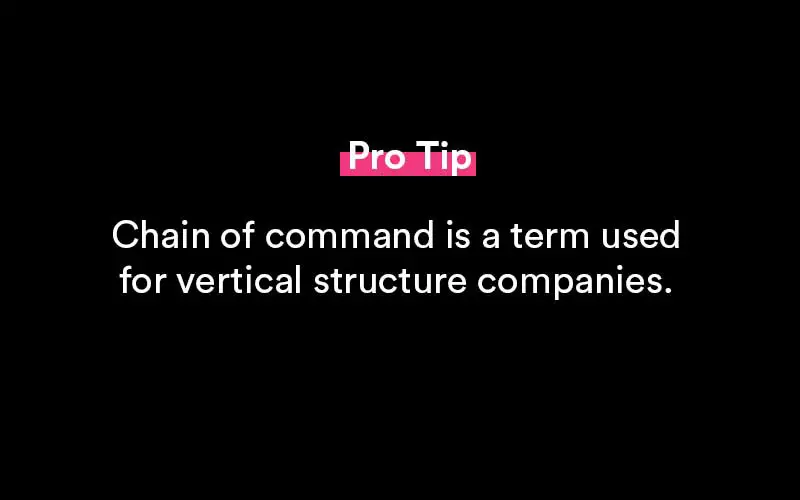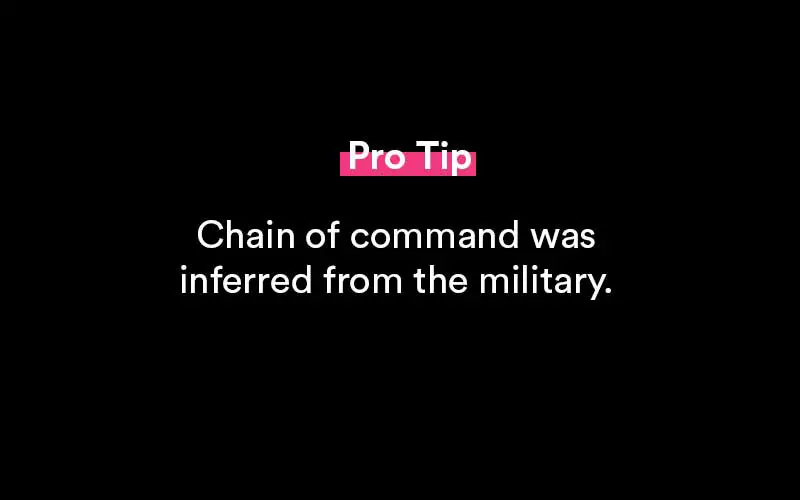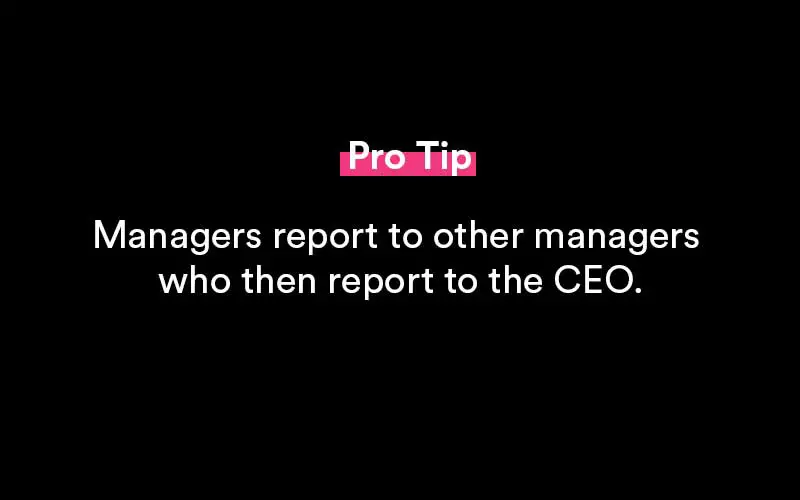Chain of Command in Business - Definition and Explanation
What is the chain of command? Or a chain of command? An organizational structure in which every employee is assigned to a specific location on an organizational chart is referred to as reporting relationships. Employees report to the employee on the organizational hierarchy who is listed above them.
Decisions and communication are closely managed and move down the chain of command across the business when every employee reports to another employee. This is a deliberate, conventional arrangement for the chain of command in companies that wish to carefully manage information transmission and power and control distribution.

What is chain of command?
If you look at relationships pictorially depicted on an organizational chart, the president or CEO (Chief Executive Officer) is the highest employee in the chain of command in the traditional chain of command. The second line of the chart would be occupied by this person's immediately reporting staff members, and so on down through the reporting connections in an organization.
A chain of command is an organizational structure that outlines how each employee in a firm reports to each other. The founder, owner, or CEO would be at the top of the chart, and those who report to them would be directly below. This cycle repeats again until the organization's whole workforce has been tallied. Employees join and depart, thus the hierarchy evolves over time.
A chain of command is used to share power and duties, keep staff informed about corporate news, and establish a knowledge-sharing mechanism.
What's the traditional command structure?
The chain of command is a time-honored method of dividing a company's power levels. The same chain of command structure may be found in a variety of organizations, from customer-based enterprises to government agencies.
Because they are the company's senior executive, a business owner or CEO is at the top of the chain of command. Senior executives or persons in vice president responsibilities over a section of the organization generally make up the next level below. These employees are directly responsible to the owner or CEO.
Individual managers or supervisors who are accountable for a whole department or group of employees can be found in top management. These workers would appear below middle management and at the bottom of the chain of command, indicating that their immediate supervisor is their authority figure. Depending on the size of the firm, the number of departments, and other factors, it's also usual to discover numerous methods to further break down the hierarchy.
The most crucial thing to understand is that the lower you are in the hierarchy, the less authority you will have. Those at the top of the hierarchy have more influence over organizational choices and are in a better position to make them.
While a chain of command has a regular structure, the terminology employed in a firm's hierarchy may vary from one organization to the next.
To characterize members of a company's hierarchy, some firms use traditional words like "superior" "subordinates," and "subordinate," while others use "team members," "workers," or real job titles.
Benefits and drawbacks to chain of command
Here are the benefits and drawbacks.
Advantages
- Employees who are accountable for conveying information, offering direction, and delegating authority and responsibility have clear reporting ties.
- In a matrix organization, when employees report to numerous bosses, each employee has just one boss, which eliminates the problem of multiple masters and contradictory directions in the chain of command.
- Each manager has supervision authority for a group of workers executing a function, and duty and accountability are clearly allocated.
- Employees are clear about who to contact for resources, help, and criticism.
- When you organize people and connections in an organized, unbending, and controlled hierarchical cascade, you gain a sense of simplicity and stability.
Efficiency
When an employee reports to only one person, they are more likely to work closely together, leading in improved communication and the capacity to solve problems rapidly. Consider a team member who is attempting to resolve a client issue.

Efficient workplaces are a significant importance to senior executives. Making structures like this more appealing.
Direction
An employee may get inconsistent orders and instructions from multiple members of management if there isn't a chain of command in place. When working on a job or project, a chain of command can assist minimize confusion or the need to determine which management to listen to.
Stability
It's common for employees to have questions or want assistance with their job throughout the day. It's also critical that they have job objectives and someone to assist them. They can experience these things because they have a line of command. Employees will know exactly who to approach for criticism or assistance, and will feel more in control of their roles and more solid in the workplace as a result.
Accountability
Supervisors and managers have a closer working connection with their direct reports when a chain of command is in place, and they are better aware of their obligations and the projects they are working on at any given moment. As employees have someone directing them to success, this may lead to improved accountability and productivity.
Responsibility
Each employee in a chain of command is responsible for their own set of tasks. Everyone knows what their work includes and what they need to do to accomplish goals and help the firm thrive when there is a chain of command in place.
Understanding
Outside of the organization, certain titles have a certain amount of clout. A dissatisfied client, for example, may want to meet with a senior management because they believe this individual is more equipped to resolve their issues.
Drawbacks
- Decision-making and authority were clearly placed in the hands of a few persons at or near the top of an organization chart during the industrial period, when employment included more repetitive processes, less information, and communication possibilities were restricted.
- Today's businesses face a variety of communication choices, more cognitively demanding and information-based occupations, and the need for speedier decision-making. In many instances, the chain of command obstructs these new organizational alternatives and demands.
- When information is readily available, a hierarchical structure that guarantees the exchange of decisions and information required by various levels of personnel is no longer essential.
- Employees must interact directly with all levels of the company in order to be flexible and make faster decisions in an agile work environment. If a customer's requirement is unmet or an employee's job is hindered, waiting many days for the boss to become accessible is unacceptable. Employees should be allowed to speak with their employer's boss or the president or make their own decisions.
Collaboration
Because people at the top of the hierarchy set the norms and standards, and expect everyone else to follow them, a chain of command can lead to less collaboration in the workplace. While employees and intermediate managers may have some voice in choices and work autonomy, it is the authority figures that approve everything and decide how the firm works.
Furthermore, if the line of command is obeyed, an employee may never have the opportunity to meet individuals above their immediate superior.
Communication
It can take some time if a question, issue, or proposal needs to be sent up multiple levels of the chain of command before being addressed or approved by top management. This can have an impact on how quickly staff can perform tasks such as finishing a project or resolving a client complaint.
Empowerment
Without a chain of command, a business is more likely to prioritize employee empowerment and providing its employees the power to make decisions about their job or a specific circumstance. Employee authority can be hampered by a chain of command.
Competition
Decision-making managers may feel competitive with their fellow managers in a chain of command because they are protective of their staff and wish to assert control over their team. This might create a distrustful environment among peer managers.
What is a flat chain of command?
When a manager has a lot of authority inside an organization, it's called a flat chain of command. They may have a large number of employees and teams reporting to them, making the organization's chain of command appear more flat or horizontal. With these sorts of hierarchies, a small number of middle managers and employees typically wield a great deal of authority and control, particularly over their own work and surroundings.
A flat chain of command may be found in any type or size of the company, although smaller firms are more likely to have this form of hierarchy because they have less personnel. The firm owner or founder may be first, followed by a middle management, and finally a group of employees.
What's a vertical chain of command?
In comparison to a flat chain of command, a vertical chain of command has more steps and levels in its hierarchy. Because each manager is usually only in charge of a few colleagues, their level of control is limited and usually limited to their department. Higher-level managers report directly to senior-level executives.
With a vertical chain of command, you may observe that the company's rules, processes, and procedures are more rigid, and they emanate from the organization's top executives, who then delegate information dissemination to other managers.

Popular Resources

Featured
35+ Phone Interview Questions & Best Sample Answers
Phone interviews have become a core part of the process when attempting to find a secured placement for an open position. Companies receive massive responses from potential candidates for any..

Featured
12+ Best Questions To Ask A Recruiter
Concerning a job search, you might receive numerous offers from your recruiters. Before you choose one, you need to assess all the conditions, for which it is vital that you know everything associated with the offered position..

Featured
Answering "What Makes You Unique" In A Job Interview
Answering this question during a job interview requires more than knowing why you are unique as an individual. Yes, the true scientific answer is made up of two main components: your..

Featured
250+ Ice Breaker Questions for Life
An ice breaker question is a question that’s asked from one person to another person in order to act as a conversation starter. It brings a connection...

Featured
10 Best Answers to "What Motivates You?"
Open-ended questions like “What motivates you?” can elicit a deer-in-the-headlights reaction from job candidates if they are unprepared. It’s a broad question and can leave the interviewer..

Featured
Answering "How Did You Hear About This Position" In An Interview
A lot of interviewers ask this question - how did you hear about this position? This way they can judge you if you are a passive or an active job seeker..

Featured
8 Best Thank You Emails After an Interview (Samples, Free Templates)
Writing a thank you note after an interview says a lot about you as a potential employee. Most notably, it says that you care about the opportunities presented..

Featured
Writing a Resignation Letter (How To Write It, Samples)
Writing the perfect letter of resignation is more of an art than it is a science. And we’re going to cover how to master that art form in this full guide..

Featured
How to End a Letter (Example Salutations, Sign Off's)
Knowing how to end a business note or email is an important skill to develop. It helps portray a sense of confidence, respect and tone to your message..
